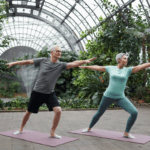Coming Soon: E-book about Kundalini Yoga - Sign up here to be among the first to get it!
Welcome to the world of chair yoga, an accessible and gentle form of yoga that is perfect for beginners, those with mobility limitations, or anyone seeking a low-impact form of exercise. Chair yoga adapts traditional yoga poses so they can be performed while seated, making yoga’s health and wellness benefits available to everyone.
This article will guide you through the basics of chair yoga, its benefits, and a simple yet very effective yoga sequence to get you started.
Embracing Chair Yoga: A Path to Accessible Wellness
Chair yoga is like opening a door to the world of wellness for those who thought it was not within reach. It’s where traditional yoga meets practicality, making peace and vitality achievable right from your seat.
Chair Yoga Defined: Adapting Traditional Poses for Accessibility
If you’ve ever felt that balance or mobility issues put yoga beyond your grasp, think again. Recent studies show chair-based exercises significantly improve physical function in older adults—chair yoga being a shining example. With a sturdy chair as your base, poses become more accessible without sacrificing their essence.
This form of practice gently invites everyone into the fold, ensuring nobody misses out on the benefits due to age or physical constraints. Just imagine turning an ordinary seated twist into an act of self-care that reaches deep into both muscle and mind.
The Therapeutic Advantages of Chair Yoga for Seniors
Focusing specifically on seniors, chair yoga presents itself as more than exercise—it’s therapy wrapped in tranquility. For those facing osteoarthritis challenges every day, they can find solace through gentle movements designed to reduce pain and enhance life quality.
Beyond individual well-being lies another gem—the sense of community this inclusive practice fosters among its practitioners. Whether it’s shared smiles during stretches or collective calmness in meditation sessions, unity blossoms here gracefully.
Clinical Evidence Supporting Chair Yoga’s Efficacy
Digging deeper into research reveals just how potent these practices are, especially when considering conditions like lower extremity osteoarthritis—a nemesis to many yet vulnerable against targeted postures done from the comfortability of one’s chair; they alleviate discomfort while lifting spirits simultaneously.
Comparing Chair Yoga to Other Chair-Based Exercises
A pilot study peered at how similar activities stack up against each other with fascinating results: whether opting for general exercises or choosing the path laid by yogic wisdom, both roads lead toward improved mobility over time, proving variety indeed spices up our quest towards better health no matter which route we take.
Integrating Chair Yoga into Your Teaching Practice
Eager instructors aiming at diversifying their class offerings can easily modify classic sequences such as Surya Namaskar so students can savor them sans strain. All thanks go towards ingenuity applied with compassion, hence creating new dimensions within teaching repertoires awaiting discovery by keen learners everywhere.
Benefits of Chair Yoga
Chair yoga stands as a beacon of hope, offering seniors the key to unlocking greater mobility and an enhanced quality of life. It is more than just a workout; it’s about reclaiming independence through gentle movements that respect the body’s limits.
Enhancing Physical Function in Older Adults
Chair yoga is effective in maintaining and developing strength in older adults. A systematic review highlighted the effectiveness of chair-based exercises, like yoga, in improving physical function, making them an ideal choice for seniors. [source]
Improving Functional Fitness and Daily Life Activities
Research indicates that chair yoga is beneficial for elderly individuals with conditions like knee osteoarthritis. It aids in improving their functional fitness and ability to perform daily activities. [source]
Effective Alternative for Osteoarthritis Management
Gentle yet effective, chair yoga meets osteoarthritis head-on by reducing pain and increasing range of motion. Studies have shown its potential in aiding those grappling with knee osteoarthritis—offering them relief and improved functional fitness necessary for everyday activities as evidenced by recent research. The slow stretches and careful poses can help ease joint stiffness while building strength where it counts.
Managing Biopsychosocial Outcomes
A pilot study compared chair yoga with chair-based exercise for older adults with lower extremity osteoarthritis. Both interventions were found to improve physical function and mobility over time, demonstrating the potential of chair yoga in managing biopsychosocial outcomes for seniors. [source]
Fostering Community Through Inclusive Practice
Inclusivity sits at the heart of chair yoga classes—they are communal hubs where support flourishes alongside flexibility. Here lies an opportunity not just for physical wellness but also social connection—a critical element often missing from traditional exercise regimens designed for older adults. By fostering this sense of belonging, practitioners find themselves partaking in something bigger than their practice: they become partakers in community resilience.
This shared journey becomes instrumental because when one person lifts another within such spaces, they reinforce each other’s commitment to health—a truly symbiotic relationship rooted in mutual encouragement.
Chair Yoga Defined: Adapting Traditional Poses for Accessibility
Diving into what makes chair yoga so effective starts by understanding its foundation—it adapts traditional poses using a chair as support. By doing so, this form empowers people with limitations to enjoy the physical benefits safely and comfortably according to systematic reviews focused on older adults’ physical function improvement through seated exercises.
This adaptation is no small feat because it ensures inclusivity within the world of wellness—a space where everyone deserves access regardless of age or ability level.
These findings highlight the value of chair yoga as a therapeutic and accessible form of gentle exercise for seniors, particularly those with limited mobility or specific health conditions like osteoarthritis. By incorporating chair yoga into yoga classes, teachers can offer a practice that not only promotes physical health but also contributes to the overall quality of life for their senior students.
Diving Deeper into Scientific Findings
In examining the findings further, it becomes clear why so many people find solace in this practice. While both interventions yielded positive results over time, there’s something unique about how chair yoga operates within our bodies and minds alike—it merges mindful movement with meditative calmness.
Studies highlight not only improved balance but also heightened cognitive clarity among participants engaging in regular sessions, showcasing how intertwining physical postures with breath control can be transformative beyond just joint health or muscle strength.
A Closer Look at Accessibility & Adaptation
The inclusive aspect cannot be overstated when comparing these modalities side by side; whereas some conventional exercises might intimidate due to perceived complexity or required fitness levels, everyone feels welcome at the table—or should I say ‘at the chair’—with this approachable form of activity.
If your body speaks up during rigorous routines asking for something gentler yet equally rewarding—the answer could very well lie here—in practicing mindful stretches and strengthening techniques without ever having to stand up.
A Beginner Chair Yoga Sequence: Suria Namaskar
First of all, choose a sturdy, armless chair that allows your feet to rest flat on the ground. Ensure your back is supported, and you have enough freedom to move your arms and legs.
We are going to explore a basic sequence of any yoga practice: Suria Namaskar.
The Chair Surya Namaskar, or Chair Sun Salutation, presents an accessible variation of the classic Surya Namaskar, tailored for those who may face challenges with traditional yoga poses. This adaptation is especially beneficial for seniors, individuals with mobility restrictions, or those with disabilities. Additionally, it offers a convenient option for people with desk jobs, providing a much-needed stretch and gentle body massage while seated, particularly for those spending extended hours in front of a computer.
In Chair Surya Namaskar, the essential elements of the traditional Sun Salutation are modified to be performed while seated, utilizing a chair for support. This adaptation is gaining popularity across various demographics, appealing to a wide range of ages and body types. It easily integrates into daily routines, making yoga more accessible and inclusive.
For yoga teachers looking to diversify their offerings, Chair Surya Namaskar is a valuable addition to their practices. It opens the door to other chair yoga variations and sequences that can be specifically tailored for senior citizens or those requiring a more restorative approach to their yoga practice.
For further exploration and inspiration, check out these articles too Beginner Yoga for Seniors: Enhancing Health and Wellness in Later Years, Boosting Wellness: An Essential Guide to Yoga for Seniors, and Gentle Yoga for Seniors.
Incorporating these sequences into your yoga classes can greatly enhance the experience and well-being of your senior students, offering them a path to improved health and vitality through the practice of yoga.

[source]
Hands Chest Chair (Chair Tadasana Anjali Mudra)
Instructions: Sit upright, feet flat on the floor. Bring palms together at the chest in the prayer position.
Variation for Seniors: Ensure back support if needed.
Benefits: This pose helps improve posture and spinal alignment, fosters a sense of grounding, calms the mind, and enhances mental focus. It’s also great for centering oneself at the beginning of a yoga practice.
Hands Up Chair
Instructions: Inhale and raise your arms above your head, keeping your shoulders relaxed.
Variation for Seniors: Raise arms as high as comfortable.
Benefits: Stretching the arms and chest in this way opens up the lungs for better breathing, relieves tension in the shoulders, and energizes the body, making it an excellent pose for improving overall vitality.
Seated Forward Fold Pose on Chair
Instructions: Exhale, hinge at the hips, and fold forward, letting your hands rest on your legs or the floor.
Variation for Seniors: Bend only as far as comfortable; use a cushion on your lap for support.
Benefits: This pose stretches the spine and hamstrings, aids in digestion, calms the nervous system, and promotes a sense of relaxation, making it particularly beneficial for stress relief.
Seated Low Lunge Variation Chair (Anjaneyasana Variation Chair)
Instructions: Place one foot on the floor in front of you, knee bent, other leg extended back with heel down. Lean into the front leg, hands on the front knee.
Variation for Seniors: Keep the back leg closer for less intensity.
Benefits: This variation gently stretches the hip flexors and quadriceps of the back leg, improves balance and concentration, and is great for opening the hips, which can help alleviate lower back discomfort.
Knee Head Down Chair (Upavistha Ardha Pawanmuktasana Janu Sirsa)
Instructions: Sit with one leg extended, the other bent with foot against the inner thigh. Lean forward towards the extended leg.
Variation for Seniors: Bend the extended leg slightly, and use a strap for the foot if needed.
Benefits: This pose offers a deep stretch for the hamstrings and lower back, promotes flexibility in the hips, and can help in relieving sciatic pain and improving digestion.
Hands Up Chair
Repeat as before.
Seated Forward Fold Pose on Chair
Repeat as before.
Seated Low Lunge Variation Chair (Anjaneyasana Variation Chair)
Repeat on the opposite side as before.
Knee Head Down Chair (Upavistha Ardha Pawanmuktasana Janu Sirsa)
Repeat on the opposite side as before.
Hands Up Chair
Repeat as before.
Seated Forward Fold Pose on Chair
Repeat as before.
Hands Up Chair
Repeat as before.
Corpse Pose Variation Chair (Savasana Variation Chair)
Instructions: Sit comfortably in the chair, close your eyes, relax your body, and focus on your breath.
Variation for Seniors: Use cushions for extra back and arm support.
Benefits: This pose allows for deep relaxation, reducing stress and anxiety. It helps in integrating the benefits of the yoga session, promoting mental clarity, and rejuvenating the body and mind.
These poses and their benefits together create a comprehensive chair yoga sequence that promotes overall wellness, especially for seniors or those with limited mobility.
FAQs in Relation to Chair Yoga for Beginners
Is chair yoga good for beginners?
Absolutely. Chair yoga offers a low-impact start, making it ideal for newbies to ease into the practice safely.
Is chair yoga good for weight loss?
Chair yoga can aid in weight management by increasing movement and burning calories at a gentle pace.
Does chair yoga for seniors really work?
Sure does. Seniors often see improved mobility and reduced pain from regular chair yoga sessions.
How many times a week should you do chair yoga?
Hitting the mat three times weekly strikes an effective balance between rest and active days for most folks.
Conclusion
Chair yoga is an incredibly inclusive form of exercise that caters to all levels of fitness and mobility. Whether you’re just starting with yoga or looking for a gentle practice, chair yoga offers a safe and effective way to improve your health and well-being. Incorporate these simple poses into your daily routine and experience the transformative power of yoga from the comfort of your chair. Remember, the journey of yoga is about personal progress and mindfulness, making chair yoga a perfect starting point for beginners.



